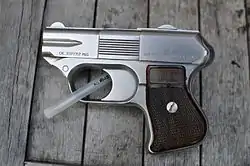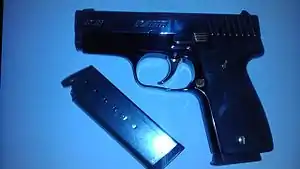Ancillary weapon
An ancillary weapon is a weapon used for secondary or auxiliary purpose, such as a bayonet, combat knife or an officer's sidearm. Through until the early 20th century, an officer's side arm was typically a sword, with the inclusion of a revolver or pistol between the mid 19th century to World War I and since World War II, a semi-automatic handgun. Some soldiers such as Special Forces soldiers whose main weapon is a rifle may also carry a pistol as a side arm.

Military
Such weapons are usually equipped with less firepower or force projection power than the primary weapon. The use of ancillary weapons most frequently occurs when the primary weapon becomes inoperable or ineffective due to running out of ammunition or an ammunition jam or when a firefight turns into close quarters combat. Some other items of military equipment not primarily intended as weapons have been used as improvised ancillary weapons in close quarters combat, including utility knives or entrenching shovels. During World War I, the entrenching shovel was also pressed into service as a melee weapon. In the close confines of a trench, rifles and fixed bayonets were often too long for effective use, and entrenching tools were often used as auxiliary arms for close-quarter fighting.[1] From 1915, soldiers on both sides routinely sharpened the edges of entrenching shovels for use as weapons.[2] In WW II, entrenching shovels were used in the brutal hand-to-hand fighting during the Battle of Stalingrad.
Many modern military vehicles, airplanes, and weapons are equipped with ancillary weapons, including tanks (a large-caliber tank cannon is the main weapon, but most tank also has a coaxial and a turret-top machine gun as ancillary weapons), jet fighters (air-to-air missiles, rocket pods and/or aerial bombs are the main armaments, but most fighters also have an autocannon as an ancillary weapon), bombers (a World War II-era B-17 Flying Fortress' main armament was up to 4,800 pounds (2,200 kg) of bombs, but it also had up to thirteen 0.50 inches (12.70 mm) machine guns as ancillary weapons for defense against enemy interceptors) and even assault rifles (the bayonet is the ancillary weapon; as well, even the wooden rifle butt can be used as an improvised, last resort weapon).
Police and security guards


.jpg.webp)
Police typically carry a semi-automatic handgun as their main weapon such as a Glock 9 mm. As well, they also carry ancillary weapons such as batons and pepper spray. In some jurisdictions, police are allowed to carry a back-up handgun in case there is a malfunction or ammunition jam with the main duty weapon. These back-up guns are usually smaller in size and caliber than the main weapon and most are suitable only for close-range self-defense. Some law enforcement officers keep the back-up gun in a different location than their duty gun or in a location that is well-concealed (e.g., in an ankle holster or in a holster in the small of the back), so that even if they have their duty handgun taken away by an armed perpetrator, they will still have a gun.
Guns used as police back-up guns include:
- The COP .357, a 4-shot Derringer-type pistol chambered for .357 Magnum, has a compact size and powerful cartridge which have made it suitable for use as a police back-up gun.
- The small Kahr K9 is designed for use as a law enforcement back-up gun.
- The subcompact Kel-Tec P-32 is designed for use as a concealed carry back-up gun.
Law enforcement SWAT team members who carry a submachine gun or rifle (e.g., an M-16 or M-4) as their main weapon may also carry a semi-automatic handgun as an ancillary weapon.
In some jurisdictions, security guards such as armored car guards who can legally carry a pistol may have the right to carry a back-up gun. This second gun is another type of ancillary weapon.
References
- Beith, Ian H. (Capt.), Modern Battle Tactics: Address Delivered April 9, 1917, National Service (June 1917), pp. 325, 328
- Ian Drury (1995). German Stormtrooper 1914–18. Osprey Publishing. p. 61. ISBN 978-1-85532-372-8.